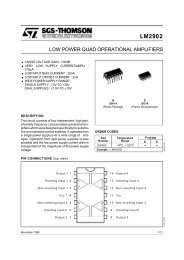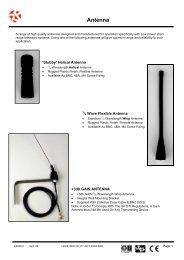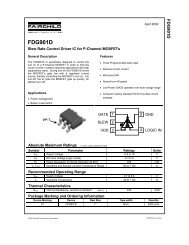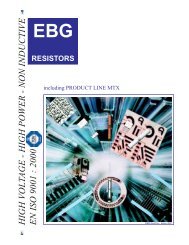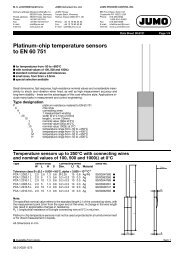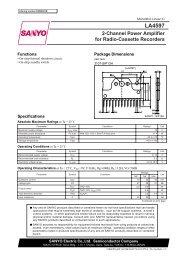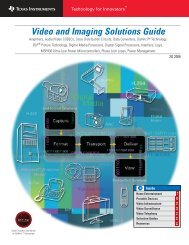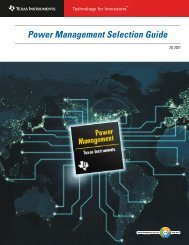DSP Selection Guide
DSP Selection Guide
DSP Selection Guide
Create successful ePaper yourself
Turn your PDF publications into a flip-book with our unique Google optimized e-Paper software.
Software and Development Tools<br />
TMS320 <strong>DSP</strong> Algorithm Standard for eXpress<strong>DSP</strong> Software<br />
87<br />
➔<br />
Codec Combinations*<br />
Video Phone/Video Conferencing Security Surveillance Networked AV/Set-Top Box<br />
H.264 BP c + G.729 AB c + G.726 c JPEG c (simultaneous, full motion) + G.711 c WMV9 MP d + WMA9 d<br />
H.264 BP c + AAC LC c MPEG-4 SP e D1 & MPEG-4 SP e CIF simultaneous, plus G.711 MPEG-2 MP d + HE-AAC d<br />
H.264 BP c + HE-AAC c DVEVM VS-B2 (H.264 BP e + G.711 e) H.264 MP d + AAC LC d<br />
MPEG-4 SP (and H.263) c + G.711 / G.726 / G.729 AB c DVEVM VS-B3 (MPEG-4 SP e + G.711 e) H.264 MP d + HE-AAC d<br />
MPEG-2 MP d + AC3 d<br />
DVEVM NAV1 (MPEG-2 d + MP3 d)<br />
*Several are available now, including the DVEVM combinations, and two of the new combinations (JPEG e/d and H.264 MP d + AAC LC d)<br />
Digital Media Software Architecture<br />
The overall software architecture for the<br />
DaVinci TMS320DM6443 and<br />
TMS320DM6446 processors is shown in<br />
the figure. TI digital media encoders and<br />
decoders seamlessly plug into the signal<br />
processing layer architecture; the right<br />
side of the diagram to the right. The<br />
codec engine framework includes code<br />
for different classes of TI digital media<br />
software. It connects to the application<br />
layer and exposes user control through<br />
the VISA API; a high-level interface that<br />
allows developers to control and operate<br />
the software from a high-level Operating<br />
System (OS) environment. TI digital<br />
media codecs allow developers to focus<br />
design efforts on differentiating features<br />
at the application layer, while DaVinci’s<br />
open software environment allows developers<br />
to include differentiating IP on any<br />
of the <strong>DSP</strong>, application or IO layers shown.<br />
Application Layer (APL)<br />
Customer<br />
Differentiation<br />
Open Source<br />
Software<br />
Middleware/<br />
Frameworks<br />
EPSI API<br />
Input/Output Layer (IOL)<br />
• Drivers (Linux)<br />
• Other operating systems<br />
(Coming soon)<br />
VISA API<br />
Signal Processing Layer (SPL)<br />
DMAN, ACPY<br />
Codec Engine Resource Server<br />
xDM<br />
Video<br />
xDM<br />
Speech<br />
xDM<br />
Imaging<br />
xDM<br />
Audio<br />
<strong>DSP</strong>/BIOS Link <strong>DSP</strong>/BIOS<br />
The overall software architecture for the DaVinci Technology-based TMS320DM644x processor is<br />
shown above. TI digital media encoders and decoders seamlessly plug into the signal-processing<br />
layer architecture; the right side of the above diagram. The codec engine framework includes<br />
code for different classes of TI digital media software. It connects to the application layer and<br />
exposes user control through the VISA API; a high-level interface that allows developers to control<br />
and operate the software from a high-level operating system (OS) environment. TI digital<br />
media codecs allow developers to focus their design efforts on differentiating features at the<br />
application layer, while DaVinci’s open software environment allows developers to include differentiating<br />
IP on any of the <strong>DSP</strong>, application, or I/O layers shown above.<br />
DSKT<br />
MEM, TSK API<br />
Texas Instruments 1Q 2007<br />
<strong>DSP</strong> <strong>Selection</strong> <strong>Guide</strong>



